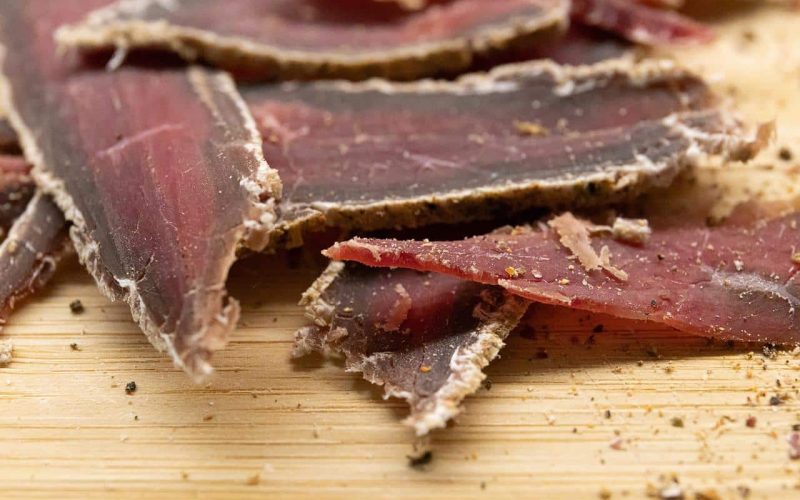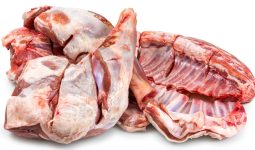Biltong and Jerky may seem similar, but there is a significant difference between biltong and jerky products.
Both are made from dried meat, but biltong and Jerky differ in several important ways, including ingredients, production methods, taste, and appearance.
If you’re wondering the difference between biltong and Jerky, read more about these two popular snack foods.
What is Biltong?
Biltong is a dried, cured meat originating in South Africa. It is typically made from beef and game meats like ostrich or venison.
The meat is cut into strips, seasoned with a vinegar-based marinade, and slowly dried over several days.
Biltong is known for its chewy texture and deep, savory flavor. While biltong originates in South Africa, it has also gained popularity across Europe and North America.
What is Jerky?
Jerky is a type of dried meat that has been seasoned and then air-dried or smoked.
The process of making jerky dates back thousands of years and was initially used to preserve meat.
Jerky is made from lean cuts of meat, such as beef, pork, or turkey. The final product is typically high in protein and low in fat.
Where Do They Come From?
Biltong is a South African dried meat typically made from beef, although other meats like the game can be used.
The word biltong comes from the Dutch words for buttock or rump (bil) and tongue (tong), which refers to the cut of meat used.
On the other hand, Jerky is a type of American dried meat typically made from beef, although poultry and game can also be used.
The word Jerky comes from the Spanish word for dry, charqui. So, what is the Difference between biltong and Jerky?
The ingredients
- Biltong is made with beef, venison, or ostrich, while Jerky can be made with any meat.
- It is cured in vinegar and spices, while Jerky is usually just dried and salted.
- Biltong is typically cut into strips, while Jerky is usually cut into small pieces or slices.
- They are chewy, while Jerky is tough.
- Biltong is lighter colored than Jerky.
- Jerky can be eaten as a snack, but biltong is usually only consumed as a meal.
- You will find more flavors and varieties of biltong than you will for jerky because it originated from South Africa rather than North America.
- While both products are high in protein, the critical difference between biltong and Jerky is that vitamins and minerals are found in biltong that are not found in Jerky.
- Biltong is a good source of fat, whereas most types of Jerky are low in fat.
- When consuming either product, keep track of your sodium intake. Both can have a lot of salt added during production.
- The texture of biltong allows it to last longer without refrigeration, while jerky needs to be refrigerated after opening.
- Each type’s taste and flavor profile varies depending on the ingredients used and different spices.
Differences in Flavor and Texture
The Difference between biltong and Jerky in terms of flavor and texture is so straightforward after having a bite.
Biltong is a South African tradition that dates back to the early 1600s, while Jerky is a North American tradition with roots in Native American culture.
It is made from whole cuts of meat, while Jerky is usually made from ground meat.
Biltong is cured in a vinegar-based marinade, while Jerky is dry-cured with salt and spices.
Biltong’s texture varies depending on how long it has been healing, while Jerky is much drier and typically doesn’t change texture over time.
Biltong tends to be spicier than Jerky because the cure includes cayenne pepper, chili powder, and other herbs and spices.
The extra ingredients used in biltong make it more flavorful than its counterpart.
Cumin, coriander, ginger, nutmeg, and black pepper are added for flavor.
Finally, biltong is mostly lean beef with just enough fat for taste. It does not shrink when heated, unlike Jerky, which shrinks considerably.
The nutritional value of the two types of food differs significantly. For example, 1 ounce (28 grams) of jerky contains 120 calories, 1 gram of protein, and 18 grams of total carbohydrates.
In contrast, 1 ounce (28 grams) of biltong contains 130 calories, 25% protein, and no carbohydrates.
Production Process
Biltong is a type of dried meat originating from South Africa, while Jerky is a type of dried meat originating from North America.
The Biggest Difference between Biltong and Jerky is the production process.
For biltong from Southern Africa, the cow or game animal is hung in a drying chamber to dry.
When it reaches an optimal moisture level (about 40% in many cases), it is taken down and cut into strips before being air-dried for another 24 hours to remove any remaining moisture.
On the other hand, Jerky’s meat must be cooked first with liquid to remove all of its natural juices.
It then undergoes a second cooking process, exposing it to high heat until it forms a rigid matrix.
This process makes it more similar to biltong than raw beef because much of its original moisture has been removed.
Which is Healthier, Biltong or Jerky?
Biltong is a South African dried meat typically made from beef, although game meats like ostrich, venison, and wildebeest can also be used.
Biltong is cured with vinegar and spices and then air-dried for several weeks.
It is a bit like American Jerky but is generally thicker, moister, and less sweet.
Because of its curing process, Biltong has a more complex flavor profile than other types of Jerky.
The result is an intense, salty taste with hints of soy sauce and wine; it’s also usually quite chewy.
The word biltong comes from the Dutch words bil (rump) and tong (strip), which refers to how this dish was initially prepared by cutting strips of raw meat off the animal’s tail.
Modern biltong recipes use marinades or dry rubs instead of essential pieces to preserve flavor better during drying periods.
Conclusion
Though both biltong and Jerky are delicious, cured meats that make for great snacks, the difference between biltong and Jerky is enormous.
Biltong is made with only meat and salt, while Jerky typically has additional ingredients like sugar, spices, and preservatives.
Biltong is air-dried for days or weeks, while Jerky is generally smoked or cooked over low heat for several hours.
As a result, biltong has a more intense flavor and a firmer texture than Jerky.
So, choose the right one when you’re in the mood for a tasty treat!








